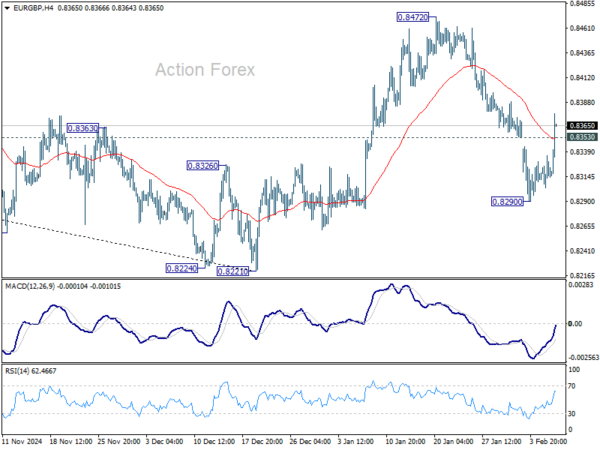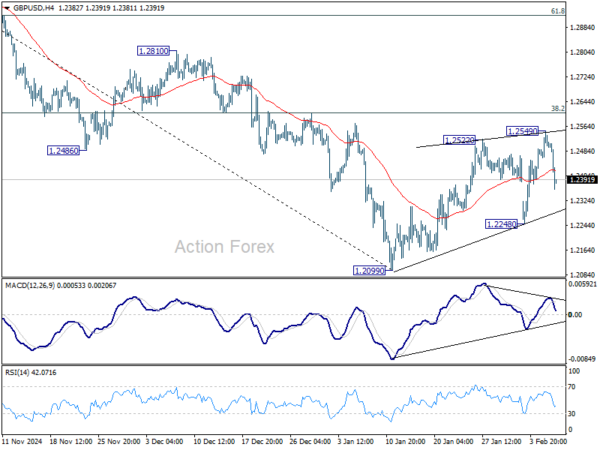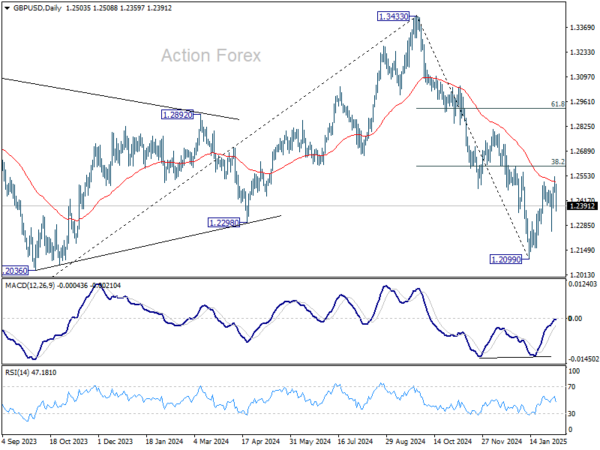The British Pound weakened significantly after BoE delivered a 25bps rate cut. The policy decision was more dovish than anticipated, primarily due to the unexpected shift in the MPC voting split. Catherine Mann, previously one of the most hawkish members of the committee, reversed course and joined Swati Dhingra in voting for a more aggressive 50bps cut.
Adding to the bearish sentiment on Sterling, BoE’s updated economic projections painted a complicated macroeconomic outlook. The central bank sharply downgraded its 2025 GDP growth forecast. At the same time, inflation forecasts were revised higher. Facing the increased uncertainty, BoE emphasized its commitment to a “gradual and careful” approach to policy easing.
Overall with today’s announcement, risk is clearly tilted toward a more dovish policy stance. The base case remains as one 25bps cut per quarter throughout 2025,. But today’s decision raises the probability of a faster easing cycle, in particular if growth conditions worsen further.
Technically, EUR/GBP’s strong break of 0.8353 minor resistance argue that the pullback from 0.8472 might have completed at 0.8290 already. This also revives that case that rebound from 0.8221 is not totally completed. Further rise is now in favor back to 0.8472 resistance next.
Overall in the currency markets, Yen is currently the strongest one, followed by Canadian, and then Dollar. Sterling is the worst, followed by Kiwi, and then Swiss Franc. Euro and Aussie are positioning in the middle. The picture is rather mixed with the exception of clear strength in Yen and weakness in Sterling. Other parts of the markets might need tomorrow’s US NFP data to provide more clarity.
In Europe at the time of writing, FTSE is up 1.53%. DAX is up 0.82%. CAC is up 0.97%, UK 10-year yield is down -0.0249 at 4.416. Germany 10-year yield is up 0.004 at 2.369. Earlier in Asia, Nikkei rose 0.61%. Hong Kong HSI rose 1.43%. China Shanghai SSE rose 1.27%. Singapore Strait Times rose 0.39%. Japan 10-year JGB yield fell -0.0166 to 1.267.
US initial jobless claims rises to 219k vs exp 214k
US initial jobless claims rose 11k to 219k in the week ending February 1, above expectation of 214k. Four-week moving average of initial claims rose 4k to 217k.
Continuing claims rose 36k to 1886k in the week ending January 25. Four-week moving average of continuing claims rose 2k to 1872k.
BoE cuts rates to 4.50% in surprisingly dovish vote
BoE lowered its policy rate by 25 basis points to 4.50%, as widely expected, but the tone of the decision was unexpectedly dovish.
The Monetary Policy Committee vote split at 7-2, with Swati Dhingra advocating for a more aggressive 50bps cut—as expected—but hawkish member Catherine Mann surprisingly joining her, marking a significant shift in her stance.
BoE emphasized a “gradual and careful” approach to easing, a slight adjustment from December’s messaging, which only referenced “gradual” reductions. This shift highlights policymakers’ growing concerns over inflation persistence and economic fragility. Governor Andrew Bailey reaffirmed that rate adjustments would be assessed on a “meeting-by-meeting” basis, with no pre-determined path for cuts.
In its updated economic projections, BoE raised its inflation outlook, now expecting headline CPI to peak at 3.7% in Q3 2025, up from a prior forecast of 2.8%. The revision reflects higher energy costs and expected increases in regulated utility and transport prices. Inflation is not anticipated to return to the 2% target until Q4 2027, six months later than previously projected.
Growth forecasts were also downgraded sharply for 2025, with expected GDP expansion halved to 0.75%, citing weak business sentiment, sluggish consumer activity, and poor productivity growth. However, projections for 2026 and 2027 were revised slightly upward to 1.5% from 1.25%, suggesting policymakers see a slow but eventual economic recovery.
ECB’s Cipollone open to March cut, flags risks of full US-China trade war
ECB Executive Board member Piero Cipollone indicating that while “there is still room for adjusting rates downwards”, the March decision remains uncertain. He stated that ECB must be “extremely careful” in its assessment, and he will enter the meeting “with an open mind”.
Discussing the concept of the neutral rate in a Reuters interview, Cipollone downplayed its practical significance in policy setting. He pointed out that when estimates for the neutral rate vary widely—such as between 1.75% and 2.25%—it becomes “not terribly useful for setting monetary policy.” If ECB operates near either end of the range, it could risk either undershooting or overshooting its inflation target.
Cipollone also raised concerns about the evolving global trade situation. The immediate impact of US tariffs depends on European retaliation and specific product categories affected, He warned that a “full trade war” between the US and China poses a more significant threat.
With China accounting for 35% of global manufacturing capacity, broad trade restrictions could flood European markets with Chinese goods. This would create a dual challenge— “deflationary” pressures from lower-priced imports and a “contractionary” effect as European producers struggle to compete.
Eurozone retail sales falls -0.2% mom in Dec, EU down -0.3% mom
Eurozone retail sales slipped by -0.2% mom in December, missing market expectations of -0.1% decline and pointing to continued weakness in consumer demand. The drop was largely driven by -0.7% contraction in food, drinks, and tobacco sales, while non-food products saw a modest 0.3% increase. Automotive fuel sales in specialized stores also ticked up 0.2%, providing some offset to the broader decline.
At the EU-wide level, retail sales fell even further, down 0.3% mom. The country-level breakdown highlights stark contrasts in retail activity. Slovenia (-2.2%), Germany (-1.6%), and Poland (-1.5%) saw the sharpest contractions, while Slovakia (+8.2%), Finland (+2.1%), and Spain (+1.4%) registered solid gains.
BoJ’s Tamura advocates rate hike to 1% by late fiscal 2025
BoJ board member Naoki Tamura, a known hawk, reinforced his stance on the need for tighter monetary policy, stating that Japan’s short-term interest rates should rise to at least 1% by the second half of fiscal 2025 to mitigate inflation risks.
Tamura explained that inflationary pressures are mounting, necessitating a shift away toward a more neutral rate. He highlighted that by late fiscal 2025, the Japanese economy is expected to reach a point where the 2% inflation target can be considered sustainably achieved, supported by broad-based wage increases, including among smaller firms.
“Bearing in mind that short-term interest rates should be at 1% by the second half of fiscal 2025, I think the Bank needs to raise rates in a timely and gradual manner, in response to the increasing likelihood of achieving its price target,” he said.
Australia’s NAB business confidence improves, but profitability weakens
Australia’s NAB Business Confidence rose from -7 to -4 in Q4, reflecting a slight improvement in sentiment. However, Business Conditions remained unchanged at 3, as trading conditions slipped from 6 to 5, and profitability turned negative from 0 to -1. Employment conditions as steady at 3.
Forward-looking indicators showed a mixed picture. Expected business conditions for the next three months edged lower, but sentiment for the 12-month horizon improved by five points, aligning with a three-point increase in capital expenditure plans, suggesting firms are cautiously optimistic about long-term prospects.
Cost pressures moderated, with labor cost growth slowing to 0.9% qoq from 1.2%, and purchase costs easing to 0.7% qoq from 1.0%. Retail price growth also softened to 0.5% qoq from 0.7%, though overall product price growth remained stable at 0.4% qoq, indicating ongoing margin pressure despite easing input costs. Wage costs remained the top concern for businesses, while demand constraints and labor shortages persisted as key challenges.
GBP/USD Mid-Day Outlook
Daily Pivots: (S1) 1.2462; (P) 1.2506; (R1) 1.2548; More…
GBP/USD dips notably today but stays above 1.2248 support and intraday bias remains neutral. While corrective rebound from 1.2099 could still extend, upside should be limited by 38.2% retracement of 1.3433 to 1.2099 at 1.2609. On the downside, break of 1.2248 support will bring retest of 1.2099 first. Firm break there will resume whole decline from 1.3433. However, decisive break of 1.2609 will raise the chance of near term reversal, and target 61.8% retracement at 1.2923.
In the bigger picture, rise from 1.0351 (2022 low) should have already completed at 1.3433 (2024 high), and the trend has reversed. Further fall is now expected as long as 1.2810 resistance holds. Deeper decline should be seen to 61.8% retracement of 1.0351 to 1.3433 at 1.1528, even as a corrective move. However, firm break of 1.2810 will dampen this bearish view and bring retest of 1.3433 high instead.



